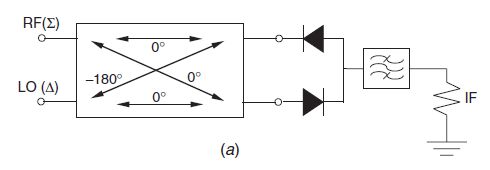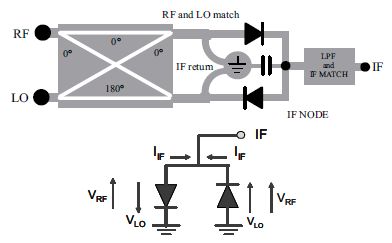EEPC
Newbie level 6

- Joined
- Oct 8, 2010
- Messages
- 14
- Helped
- 0
- Reputation
- 0
- Reaction score
- 0
- Trophy points
- 1,281
- Activity points
- 1,459
Hi all, I have a quick question about how a single-balanced diode mixer works. Here is a picture of the circuit:

Suppose the RF voltage has amplitude Vrf and LO signal has amplitude Vlo, and there is a RF bypass to ground at the node between the two diodes. Then the amplitude of voltage at the left terminal of the top diode is (Vrf - Vlo) while the voltage at the left terminal of the bottom diode is (Vrf + Vlo), right?
I don't really understand how current flows out of the IF node, because it seems that two diodes in series will just conduct current in one direction only (and zero current will flow into the IF branch).
Can anyone help explain to me precisely how this circuit works? Thanks!

Suppose the RF voltage has amplitude Vrf and LO signal has amplitude Vlo, and there is a RF bypass to ground at the node between the two diodes. Then the amplitude of voltage at the left terminal of the top diode is (Vrf - Vlo) while the voltage at the left terminal of the bottom diode is (Vrf + Vlo), right?
I don't really understand how current flows out of the IF node, because it seems that two diodes in series will just conduct current in one direction only (and zero current will flow into the IF branch).
Can anyone help explain to me precisely how this circuit works? Thanks!


